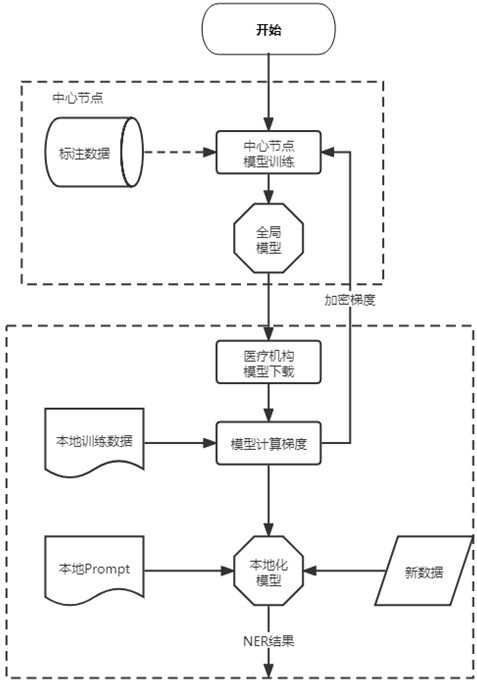Medical named entity recognition model training method, recognition method and federal learning system
A technology of named entity recognition and model training, which is applied in neural learning methods, character and pattern recognition, and biological neural network models. Data Leakage Risks, Good Controls, and Expected Effects
- Summary
- Abstract
- Description
- Claims
- Application Information
AI Technical Summary
Problems solved by technology
Method used
Image
Examples
Embodiment 1
[0058] Such as figure 1 As shown, the first aspect of the present invention provides a medical named entity recognition model training method. The method may be performed by a medical institution node, and the medical institution node may refer to an institution performing model training based on a distributed server in the federated learning system, or may refer to the distributed server itself in the federated learning system, specifically including:
[0059] S101. Receive a global model for identifying medical named entities sent by a central server.
[0060] The overall federated learning framework of the present invention is for example figure 2 As shown, including central server and distributed server. Among them, the distributed server corresponds to the medical named entity recognition system distributed in various medical institutions, and is used for local model training and prediction, while the central server is responsible for initial model training, model deli...
Embodiment 2
[0083] Such as Figure 4 As shown, the second aspect of the present invention provides a medical named entity recognition model training method. The method can be executed by the central server, and specifically includes:
[0084] S201. Distribute the global model for identifying medical named entities to each medical institution node in the federated learning system, so that each of the medical institution nodes trains the global model based on their respective local medical text annotation data, and calculates The corresponding gradient data.
[0085] S202. Receive gradient data respectively sent by each of the medical institution nodes, and train the global model based on each of the gradient data to obtain a new global model.
[0086] S203. If the new global model is currently converged, distribute the converged global model to each of the medical institution nodes in the federated learning system, so that each of the medical institution nodes is based on their correspon...
Embodiment 3
[0096] Such as Figure 5 As shown, the present invention provides a localized medical named entity recognition model training method in a third aspect, the method is executed by a medical institution node, and specifically includes:
[0097] S301. Obtain medical data.
[0098] In S301, the medical institution node can perform data cleaning, invalid data screening, and data format standardization processing on the medical data based on preset preprocessing rules, so as to further improve the execution efficiency and accuracy of S302.
[0099] S302. Input the medical data into a localized medical named entity recognition model, so that the localized medical named entity recognition model outputs a medical named entity recognition result corresponding to the medical data.
[0100] Wherein, the localized medical named entity recognition model is obtained in advance based on the medical named entity recognition model training method described in the first aspect.
[0101] After S...
PUM
 Login to View More
Login to View More Abstract
Description
Claims
Application Information
 Login to View More
Login to View More - R&D
- Intellectual Property
- Life Sciences
- Materials
- Tech Scout
- Unparalleled Data Quality
- Higher Quality Content
- 60% Fewer Hallucinations
Browse by: Latest US Patents, China's latest patents, Technical Efficacy Thesaurus, Application Domain, Technology Topic, Popular Technical Reports.
© 2025 PatSnap. All rights reserved.Legal|Privacy policy|Modern Slavery Act Transparency Statement|Sitemap|About US| Contact US: help@patsnap.com



